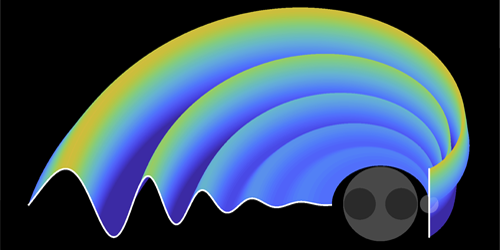On-Demand Solutions for Black Hole Mergers
The recently upgraded LIGO and Virgo gravitational-wave detectors had a whirlwind April, detecting five candidate black hole mergers. This detection flurry increases the need for fast and accurate methods to extract the properties of the merging black holes from the measured gravitational-wave signals. Currently, researchers rely on fitting methods based on numerical relativity. These methods can be computationally intensive and are inaccurate for some black hole masses and rotation speeds. Now, Sean McWilliams of West Virginia University, Morgantown, has proposed a new analytical method for calculating black hole properties from gravitational-wave data that could provide the information almost instantaneously. Since the method is grounded in a first-principles description of the merger, McWilliams expects it could tackle parameter combinations that are out of reach of numerical relativity.
Finding the exact solutions of Einstein’s equations for a black hole merger is currently unthinkable. Instead, McWilliams simplified the problem by making two approximations. The first approximates the spacetime of two coalescing black holes as being a perturbation of the spacetime of the black hole produced by the merger. The second assumes that certain nonlinear effects remain small during the coalescence process.
Using these conditions, McWilliams derived analytical expressions for the gravitational-wave signal at a detector as a function of merger parameters. He then compared his predictions with those made using numerical-relativity-based models for a broad range of merger events, including those for two black holes with similar masses, those where the masses differ significantly, and those for mergers of black holes with very large rotation speeds. Within the accuracy of numerical relativity, he found that the two sets of solutions were indistinguishable.
This research is published in Physical Review Letters.
–Matteo Rini
Matteo Rini is the Deputy Editor of Physics.





